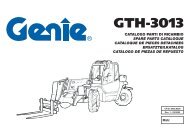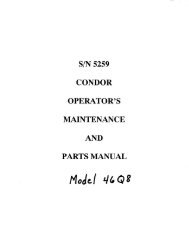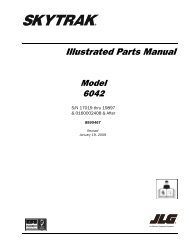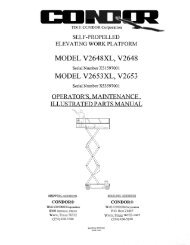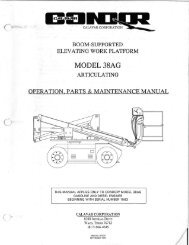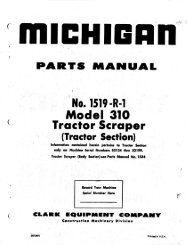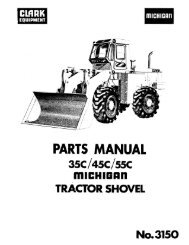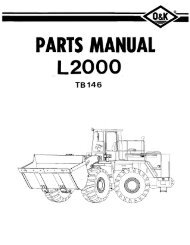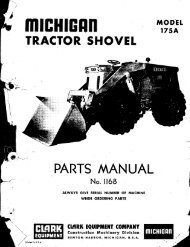MODEL V1433XL, V1433 MODEL V1833XL, V1833 - MinnPar
MODEL V1433XL, V1433 MODEL V1833XL, V1833 - MinnPar
MODEL V1433XL, V1433 MODEL V1833XL, V1833 - MinnPar
- No tags were found...
You also want an ePaper? Increase the reach of your titles
YUMPU automatically turns print PDFs into web optimized ePapers that Google loves.
Next, wipe with a cloth with clear water. After rust is removed from a part with a wire brush,rinse with clear water, dry and paint with an acid-resistant paint.If corrosion is found on the terminal posts, remove the cable terminals from the battery (groundcable first), using the proper end wrench. A wire cleaning brush can be used to clean the posts and themating surfaces of the cable clamps. Connect the cables to the terminal posts (ground cable last). Coatthe terminal connections with a spray corrosion inhibitor or high temperature grease.The second item in routine servicing of conventional batteries is to check the electrolyte level inall cells. Ifnecessary, add clear, odorless, mineral free water to bring the liquid level to the level indicatorin all cells. If the battery does not have a level indicator, bring the level to 112" (13mm) above the topsof the separators. Do not overfill any cell. When a cell is overfilled, the excess electrolyte may beforced from the cell by the gas formed in the battery. This will cause excessive corrosion of adjacentmetal parts, reduced performance and shorter life.BATTERY TESTINGBattery testing should be considered an integral part of periodic equipment maintenance and should beperformed whether or not a starting problem has occurred. Servicing the battery in the equipment asdescribed will help prevent premature battery failure from external causes and periodic battery failurefrom both external and internal causes or merely from the battery reaching the end of its useful life.STEP 1-VISUAL INSPECTIONFor protection, wear a face shield. First, visually inspect the battery. Check for container,cover or terminal damage that might cause leakage of electrolyte or internal damage. If serious damageis found, replace the battery. Check the electrolyte level in each cell. If below the tops of the plates inany cells, fill all cells with water to just above the tops of the separators and charge for 15 minutes at 15-25 amps to mix the water with the electrolyte. If electrolyte levels are above the tops of the plates,continue to Step 2.STEP 2 -HYDROMETER TESTUsing the hydrometer, measure and record the specific gravity (sp. gr.), corrected to 80 degreesF (26.7 C) of the electrolyte in each cell. Iftherange (highest-lowest) is 50 points (0.050 sp. gr.) or greaterorthe lowest is less than 1.225 sp.gr., charge the battery atthe recommended rate or until all cells are 1.225sp.gr. or greater and the range is less than 50 points. If no amount of charging will achieve theseI,DANGERLead acid batteries generate highly explosive hydrogen gas especially during thecharging cycle. To AVOID the possibility of an explosion, charge batteries ONLYin a well VENTILATED AREA. Keep fire, sparks, and burning material away fromthe charging area. Do Not smoke near a battery, and always shield the eyes whenworking near a battery.MANUAL 92370-002November 1997



